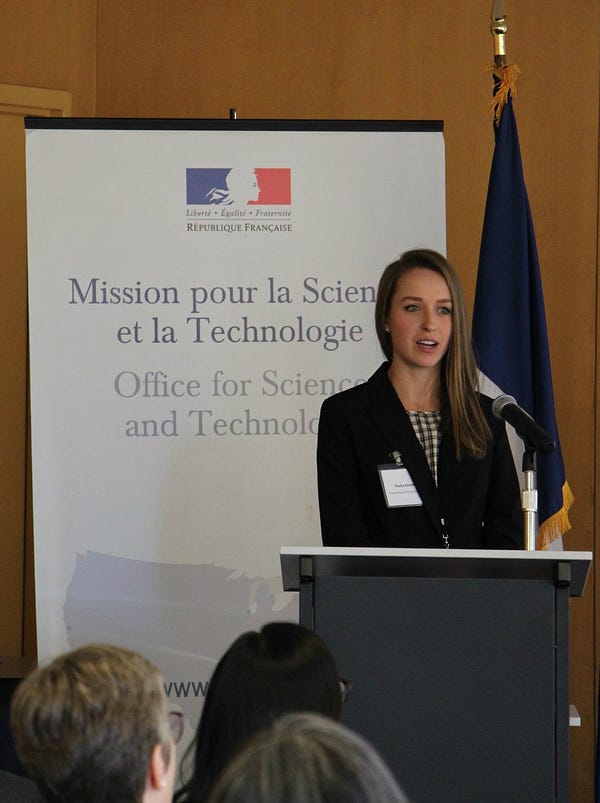
Nadia Krook: Building Opportunities for the Future (4)
Nadia Krook is a fourth-year Ph.D. student in the Department of Materials Science and Engineering and is co-advised by professors Russell Composto and Christopher Murray. She is part of a wide-ranging research project to develop materials for multifunctional coatings on emergency tents. The goal: enabling the tents to manage water, prevent the spread of bacteria and capture and store solar energy. These disparate capabilities all stem from fundamental research on how materials behave on the nanoscale, where minute structural details can produce large-scale effects.
The project, REACT, or Research and Education in Active Coating Technologies, is supported by a five-year, $3.6 million grant from the National Science Foundation. REACT is also part of the NSF’s Partnerships in International Research and Education program, which seeks to foster global collaborations on topics of societal importance. Krook recently took part in a workshop at the French Embassy in Washington, D.C., where she and her counterparts from other partner institutions discussed technical progress and the impact those developments could have on the world at large.
I joined the University of Pennsylvania’s Research and Education in Active Coating Technologies (REACT) team as a fellow in December 2016, and since then, I have been afforded the unique opportunity to develop my skills beyond the conventional engineering Ph.D. experience.
Through this program, I have been able to conduct research on polymer nanocomposites that could help us maximize the use of the solar spectrum for energy generation. It has been inspiring to motivate my work in the context of a coating that could benefit the human habitat in times of disaster. In the summer of 2017, I traveled to Grenoble, France, for a few months to continue my Ph.D. research with REACT’s talented international partners. The experience abroad sparked new collaborations that enabled me to not only approach my work from a different perspective, but also use new techniques that I didn’t have access to in my home lab. In addition to research, fellows take part in a variety of educational initiatives such as teaching and professional development workshops. Such trainings have allowed me to also focus on improving my soft skills, such as mentorship and communication.
At the culmination of my tenure, the highlight event for me that brought all these aspects together in one room was my trip to the French Embassy in Washington, D.C., on November 27, 2017. On a day that started with coffee and croissants, REACT members from both the U.S. and France, funding agencies, NGOs, industry collaborators, and embassy members were all in attendance for a workshop that truly brought all facets of the program to life.
The day’s conversations were stimulating and diverse, but had an underlying message that REACT’s goals could have a real impact. By engineering solutions from a fundamental understanding of material design, some of the world’s most challenging problems could be addressed.

The morning talks highlighted the research progress in creating hierarchical structures for water management, understanding how to prevent infection transmission, and producing self-assembled nanomaterials for energy applications. Afternoon roundtable discussions featured a variety of speakers, including a corporate research manager from Solvay, a director at the Nanosciences Foundation, CEA Tech’s vice president for strategic partnerships in North America, a co-team leader from the World Bank, and a division chief from USAID.
Each individual emphasized the importance of translating and extending our findings in the lab into practice to meet critical societal needs. In the conversations throughout the day, attendees all seemed to agree that REACT’s mission would have positive implications on the global level. It was clear, however, that the progress and success of the program has been made possible by all of the the vast REACT connections and collaborations — only a small sample of which were featured that day.
The collaborations in the REACT community are extensive. Local connections that began within individual laboratories at Penn have transformed to include different interdisciplinary laboratories across Penn. Furthermore, REACT extends to multiple U.S. institutions, including Alabama State University, Villanova University, and Bryn Mawr, and networks with a variety of corporate partners. Outside the U.S., the program’s community includes multiple institutions within the Grenoble Innovation for Advanced New Technologies (GIANT). Both the national and international relationships that the program fosters are strong and are growing.
There are a multitude of benefits that result from interdisciplinary activities. Personally, my work has grown and adapted since I joined REACT, especially after traveling to France. Six months following my return, the conversations with my French collaborators have continued and are still influential in my progress. The workshop at the Embassy had a lot of familiar faces, but several new faces as well. All of the attendees that day became participants in the REACT community and once you’re connected, the relationship grows. REACT has flourished since its inception and continues on its path to making a significant impact.
Apart from reconnecting with collaborators at the Embassy, this event was a pivotal career-development moment for me. So many of the attendees represented different organizations and institutions. While the majority had STEM-related backgrounds, their career trajectories propelled them into a wide variety of professions. The REACT network exposes its fellows to possible career options beyond the perhaps traditional routes to academia or industry. It was encouraging to see possible opportunities for the future. Even if each individual’s career launched them to a different track, it was exciting to see such a diverse group of people come together and share a common passion to implement solutions to benefit the human habitat.
I believe, that among many things, the strength of the REACT program is to prepare the next generation of students to be collaborative, international leaders in STEM-related fields. Through conversations, collaborations, and career development opportunities paired with coffee and croissants, the fellows, including myself, are able to excel inside and outside the lab spaces.



